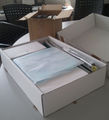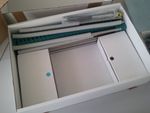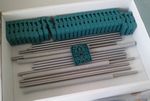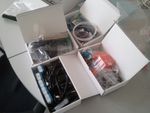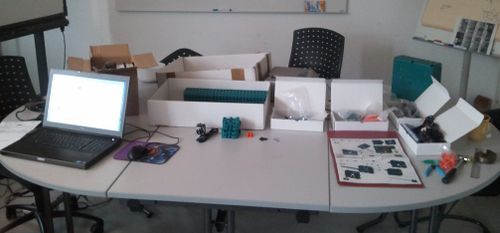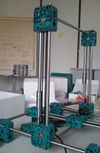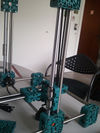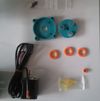Fabbster 3D printer: Difference between revisions
m (→Preparation) |
m (→Preparation) |
||
| Line 75: | Line 75: | ||
* Insert a graphic upfront that labels the most important elements (axis, names of the motors) | * Insert a graphic upfront that labels the most important elements (axis, names of the motors) | ||
; Table | ; Table | ||
[[image:fabbster-6.jpg|thumb|500px|none|Fabbster - Table layout]] | |||
* Bigger is better | * Bigger is better | ||
Revision as of 21:30, 25 April 2012
The Fabbster is a low cost 3D printer kit that can be assembled in about 4 hours.
Soon - Daniel K. Schneider 14:11, 24 April 2012 (CEST)
The fabbster kit
Getting it The kit is sold through retailers and costs about 1500 € (incl. VAT., e.g. here). I got ours for 500 € through their (March 2012) pilot program.
Software
- A basic slicer program (STL to machine code configurator/translator) from Netfabb is included in the price.
- The printer comes with an electronic box that can print either through a connected PC or via an USB stick.
- Driver software for Windows XP/VISTA/7 can be downloaded from the wiki.
Materials
- Custom made ABS sticks or 3mm ABS rolls
- PLA sticks or rolls
The parts
Unlike the RapMan, the fabbster is based on very few different kinds of parts:
- Most of the structure uses so-called "cassettes", i.e. good for most everything 8.5x7.6cm plastic parts
- Most screws and bolts have the same size.
The assembly manual
- Assembly is described in a bilingual German/English assembly handbook (Version 1.10 is a color PDF file in A4 portrait format and includes 57 pages and about 42 for the assembly process itself.
- Steps are explained on sheets that included the following information:
- Parts (prepare them first)
- A graphic explaining the assembly step
- Some detail views
- A global progress view
Other documentation
- Wiki
- support forums
Assembly
Important disclaimer. These tips refer to a pilot program machine and beta manual version 1.10. The model that will be shipped to normal customers might be different: Colors may change, manual will change, etc. - Daniel K. Schneider 17:12, 25 April 2012 (CEST).
Below, we shall not describe the whole assembly since there is a good manual. We just will write down some tips and problems we found.
Preparation
- Retrieve it
- Before you open the boxes, take a picture. This makes an nice souvenir. More importantly such a picture is useful in case something is damaged as I learned just a week ago. I also ordered a (pre-assembled Felixprinter) and on arrival it was broken. Must have fallen off a truck or something.
- Inventory
- Open the box. Ideally you should have a fairly big table at your disposal during assembly.
- Make inventory of the parts (I skipped that). The manual includes a part list
- Inside the box
- Tools needed
- Most tools needed come with the kit: a hammer, 2 allen keys and cutting pliers (clippers)
- Additional tools suggested: A ruler, a (cheap) electronic caliper, plastic tape, 1 2nd allen key (like the bigger green one, preferably a high-quality smaller one with a ball end)
- You can use an electric screwdriver, but use minimal force
- Mental preparation
- Look at the pictures at the end of the manual in order to understand what you are going to build
- Suggestion for the end-user manual
- Insert a graphic upfront that labels the most important elements (axis, names of the motors)
- Table
- Bigger is better
Step 1 - p. 10
Manual improvement:
- The icon of the B4 screw should be changed, it's really small and black. Although it's ok in the detailed picture.
Tips:
- To keep the two big nuts in place, use some light tape. This allows to put the motor on the table and the plastic on top and you then can add the 4 screws and push in the orange part. You can pull out the tape before you enter the screw (do the other 3 first).
- The orange pulley is hard to push onto the motor shaft. Don't push it too far since it is difficult to pull it out again.
Steps 2 & 3 - p. 11/12
Tips:
- Insert the E4 clamps first
- Tape down the 9 nuts and put the cassette on the table (nuts down)
- Insert the bolts in the other cassette, turn it and press it onto the table so that the bolts will move in.
- Alternatively (faster): Put 4 corner bolts on the table, cassette on top, then insert 4 bolts, then the rest one by one
- The head of a B1 bolt is about 5mm (helps positioning the rod)
Step 4
- Manual
- Not clear how far to push in the rods (5mm like above) ?
- Tips
- none, this is an easy step. Well, don't forget to push in both rods first.
Step 5
- This will create a part of the y axis (opposite the motor in step 7)
Tips:
- Be careful not to forget the anything !
- Holes for the clamps are bit too narrow. Try to push the clamps in with a rod
- Put 4 cassettes under the lower cassette in order to be able to work on it (picture)
- Make sure that the assemble cassettes remain in the middle of the rod (edge to edge distances about 16cm)
Step 6
Tips:
- Turn the cassette up, pull out the belt, before inserting the rods
- The linear bearings C2 are in the little blue boxes.
Step 7
Tips:
- Verify that the motor is well attached, i.e. tighten the screws if needed
- Verify that the orange pulley is pushed into the motor shaft like it should, i.e. about 2mm left. Use your new fancy blue pliers to cut a small piece of a 2mm thick object and put it in the hole. A standard small match that you can get for free is about 2mm in diameter
- Make sure that the clamps are well in place
- Finally: remember that it's useless to tighten the screws a lot since you will have to calibrate the whole geometry later, i.e. you will have to pull cassettes out so that the belts are tight and the whole is a prefect rectangle.
Step 8
Tips:
- Again: You could put three other cassettes underneath the bottom cassette in order to work on it comfortably
- Make sure the that linear bearings fit snugly into place. They should not move.
- Make sure that the belt touches the bottom of the cassette. Only then add the little green piece that will block the belt.
- Then screw 4 corners first and the remove support cassettes and do the rest.
Steps 9 & 12
Tips
- Tighten the screws of the motor
- If you prefer working "flat", look at the picture to the right
- Leave the nuts quite loose, because you will have to insert rods in step 10
Steps 10 & 13
(easy)
- Tighten the bolts a bit
Steps 11 & 14
Tips:
- Make sure that the bearings are well pushed down into the casing of the cassette
- Make sure that the belt turns
Step 15
(easy)
Tips:
- Insert the rods first
- Lower rod is towards front, upper towards back
- Calibrate a bit: Upper rod should stick in like the lower (i.e. each rod should be pushed in about 5mm. Use the cap of a black (normal) bolt as cue. It's 5mm.
Step 16
X-axis motor on the z-axis (moving up and down)
Tips:
- Push in 6 black bolts first (middle and outside)
- Make sure that the linear bearings fit snugly, and then push the cassette down
- Do not forget that the belt (one end) must be inside (that was my only big mistake so far and I discovered it on Step 18 ...)
- Do not tighten since you will have to push in rods in step 17
- Finally I find it easier to do step 18 first
Step 17
(easy, but don't forget the linear bearings !)
Step 18
X-axis - the other end
This is the most difficult assembly step so far. You may ask a person to help.
Tips:
- Push in 6 black bolts first (middle and outside)
- Make sure that the linear bearings fit snugly, and then push the cassette down
- Keep one side of the belt inside
Step 19
Cassette for extruder
Tips:
- As always, make sure that every thing fits. In particular, be careful to stick the belt "behind" the green piece that will block it.
- In case the belt is too tight (was my case), adjust the geometry, uptight the 4x2 bolts that hold the 3 lower and the upper horizontal rod and gently hammer the cassettes in.
Step 20
Extruder motor
Tips:
- Attach the green casing to the motor first. Tighten the screws.
- Push down the little orange center gear. I used the hole of cassette for starters, then a border
- Grease the planet gears (inside) and assemble. I put the gears into the casing and then added the top, but there may be a better way ....
- Test if you can turn it. There is some resistance though.
Step 21
(easy, attach the motor to the x-axis cassette)
Steps 22 and 23
Calibration
Tips:
- Open the green plastic box (electronics) and remove the SD card that is taped there.
- Insert the 2 bolts like in the picture (right)
- Then make the case with the electronics fit (distance between the cassettes is about 12cm (a tiny bit less)
- You now likely will have to push the whole vertical frame backwards or forwards a bit
- You probably will have to loosen at least 2x6 of the bolts
- On the other side, I did not attache the other e-box part, but I used a caliper (faster and probably more precise)
Step 24
Calibration continued (y-axis belt)
Tips:
- Loosen the bolts of the three font cassettes (if needed). I.e. I suggest loosing the 3x5 that are close to the rods.
- Then do the 16cm - 16cm calibration of the y axis (both in front and back). The point is that this axis should be at 90 degrees. Also, you should anticipate step 26, i.e. also try to get the x-axis belt tight.
- Then hammer a tiny bit on each outer cassette until the middle y-axis belt (that will move the platform) is tight.
- I also suggest using a caliper to make distances on both sides equal. I got distances of about 125.8 mm, but this can be different on yours. Depends on how far you pushed in your rods. The more rectangular you geometry is, the better print quality will be (that's what I learned from my RapMan
- In order to test tension (2-3 seconds of vibration), move the gliding cassette to one end. Belts should be tight, but not too tight. Very short vibes means too tight.
Step 25
Calibration of z-axis
Tips:
- Listen to the sound of the vibrating belts, left and right must be same
- Slide the y-axis (extruder) up/down, it should be smooth
- Once your are done, tighten the lateral bolts
Step 26
Calibration of x-axis
Tips:
- This is probably the most difficult to fix, since you will have to work on 8 cassettes, i.e. 4 rods. Loosen all the upper rods if hammering doesn't work
- I was lucky and didn't have to change anything, since I paid attention to this step already in step 24 :)
Step 26
Final test
- All three cassettes on the axis move nicely
- All belts vibrate 2-3 seconds
- The geometry should be strictly equal distances between cassettes and 90 degree angles
- If something is wrong, repeat any steps 22-26 above
- Now tighten all the bolts. However, there is not need to tighten like a nut (pun intended). If you tighten too much, you could squeeze the linear bearings or even break something.
to be continued.
Links
- Official
- Fabbster Home
- Fabbster forums]
- Fabbster wiki (Includes all the documentation). Sometimes, a wiki page just links to a file, e.g.
- assembly handbook
- drivers and software

